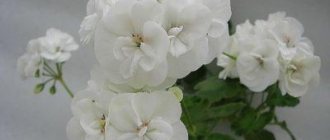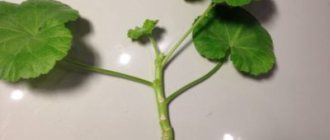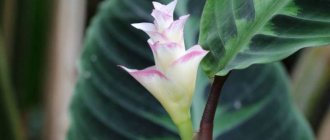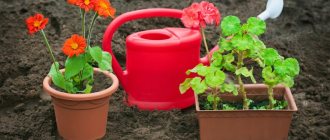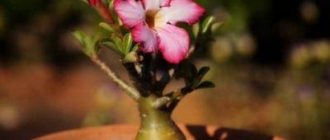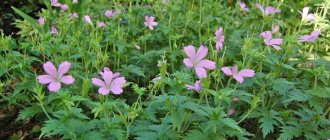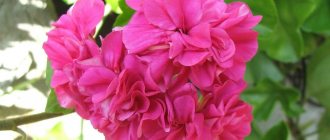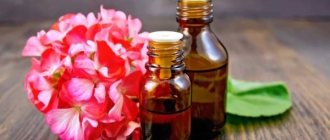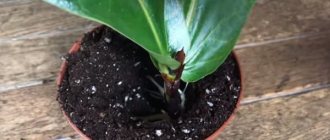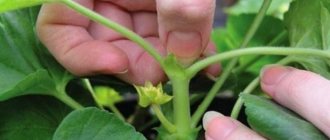Main reasons
Geranium is an unpretentious plant, so it can be planted by novice gardeners.
Over the years of selection, hundreds of varieties have been bred, which differ not only in color, but also in flower shape. This variety quickly made geraniums popular. Specimens without flowers look unattractive
The plant is correctly called pelargonium, but this name did not stick. Some varieties can be grown in the garden. Zonal species bloom almost all year round. Their peculiarity is that the flowers have several shades.
A compact geranium with an unobtrusive aroma is Fragrant. The most beautiful is the Royal Pelargonium. Flowers can reach a diameter of 15 cm, with a dark spot on each petal.
Important! At home, geranium blooms from March to September. To do this, you need to create the right conditions
Correct pinching
Timely pruning of weak and elongated branches allows you to save the plant’s strength. Pinching allows you to stimulate the appearance of side shoots, which can also bloom.
Pruning should be done in early spring. To do this, the upper part of the stem is removed. It can be rooted and sprouted separately
Young plants (up to two years old) are pruned once every 3-4 months, since at this stage it is important to achieve the correct formation of the crown
Pinching is carried out with a clean stationery knife or scissors. If the branches have become too long, they can be trimmed a little more. It is better to place the pot with the plant in a sunny place, as the light will allow it to recover faster.
Without pinching, geraniums look unsightly, as the stems can become very stretched.
Important! Special attention should be paid to the condition of the stems. If they are affected by diseases or pests, they need to be cut off along with a healthy area of 3-4 cm
Incorrect pruning
Many people want to achieve wild flowering of geraniums and use various tricks to achieve this. Any pruning must be carried out according to the rules, otherwise it will harm the plant.
The shoot is cut only by 1/3 and the uppermost part is removed. It is this technique that helps awaken the lateral buds. Sometimes a person can overdo it and remove most of the stem. In this case, the geranium may stop growing for some time.
Important! If there is a fear of removing too much, then it is enough to remove 2-3 cm of the top of the shoot. It is impossible to correct incorrect pruning; all you can do is wait for it to grow stems
In this case, you can find out how to fertilize geraniums, since fertilizing stimulates growth
It is impossible to correct incorrect pruning; you can only wait for it to grow stems. In this case, you can find out how to fertilize geraniums, since fertilizing stimulates growth.
cramped potty
Timely replanting of geraniums allows the root system to develop correctly. If there is a lack of soil, a deficiency of nutrients occurs and the geranium will not have enough strength to form buds.
An overly large pot will also do harm, since then the plant will begin to actively grow root mass, rather than flower stalks. Determining the size of a normal container is simple - it should be 1-2 cm larger than the earthen clod.
You can determine the tightness of the pot visually. Roots will be visible above the soil's surface and may also grow through drainage holes.
Important! Geraniums up to three years old are replanted every year in early spring. This must be done before flowering begins.
Plants older than three years are replanted once every two to three years.
Temperature violations
Making geraniums bloom is not so easy, since the formation of buds occurs only when special conditions are created.
A period of rest is necessary to stimulate flowering
In spring, summer and autumn, the temperature should be maintained at 23-25 °C, and in winter it should be lowered to 16 °C. Such changes will allow the plant to expend less energy and accumulate nutrients in the stems and leaves.
During the dormant period, geraniums are rarely watered and receive light for at least 5 hours a day.
Important! When winter passes, you can begin to gradually increase the temperature and the amount of watering. The appearance of the plant can indicate the correctness of the regime.
Red foliage indicates that the geranium is freezing and needs to be placed in a warm place
The appearance of the plant can indicate the correctness of the regime. Red foliage indicates that the geranium is freezing and needs to be placed in a warm place.
What determines the fluffiness of geraniums?
Flower growers value geranium, also called pelargonium, for its unpretentiousness, abundant flowering and decorative appearance. When growing it, it is important to know the peculiarities of flower formation: how to prune pelargonium to get an attractive fluffy bush with abundant and long-lasting flowering.
There are several important factors in care that determine how decorative and fluffy a flower will be.
Firstly, this is lighting. Geranium is a light-loving crop. If you do not take care of it and grow it in a lack of light, the lower leaves fall off, the branches begin to stretch strongly, and the stem becomes bare.
A sufficient amount of nutrients during the growth period is an important factor in care. It plays a significant role in the growth of green mass and the formation of a well-leafed fluffy bush. With a lack of microelements, the growth of pelargonium may slow down, the leaves turn yellow and fall off.
The third and most important factor is proper crown pruning. It is necessary to prune pelargonium, as this care procedure allows you to awaken dormant buds and get a fluffy bush. Pruning is also important for setting inflorescences and abundant flowering.
How to make geraniums bloom
If a geranium does not bloom, it is not satisfied with the conditions in which it is located, or the plant is not healthy. First you need to review the temperature conditions and watering regime. If the plant is indifferent to air humidity, then a lot depends on the condition of the soil.
Conditions for flowering
Overwatering is dangerous for the plant; stagnation of water leads to rotting of the roots and death of pelargonium. To prevent this from happening, drainage mixtures are used. The plant needs to be watered when the top layer of soil dries out. It is recommended to moisten young flowers and shoots using a tray in which the pot is located. In addition to excessive watering, the roots of the plant can be seriously damaged by insects or fungal diseases. Eliminating them does not cause problems; this is done using special means by removing the affected areas of the plant. If the problem was pests, the pelargonium will soon recover and bloom.
We must remember! The planting container should be small in size. It is better for the plant to be slightly cramped than too spacious. If geranium grows in boxes, then the distance between flowers should be about 3 centimeters. You can plant several bushes in one pot; it is believed that pelargonium loves competition. Therefore, such conditions will give impetus to flowering.
Also, one of the reasons why pelargonium does not bloom is the lack of sunlight or its excess. The main thing is to avoid direct rays, but also not to keep the plant in the shade all day long. In such conditions, the plant will survive, but will not be attractive and will lose its decorative appearance. Royal geranium, which is distinguished by larger leaves, especially loves light.
Geranium in bloom
Expert advice
To make geraniums bloom, experts recommend giving them a temperature difference. For example, send it to a cool balcony or take it out into the garden. This is true for spring and summer, when warmth during the day gives way to coolness at night. In this case, frost and temperatures close to zero must be avoided, otherwise the plant will die. There should also be no drafts that harm pelargonium.
Perhaps the plant is not in the right place, so you can move it around the room in search of a comfortable position. If the geranium starts to bloom, you need to leave it alone.
It is not recommended to place geranium next to moisture-loving plants; this can cause yellowing of the leaves and affect flowering.
Soil composition
Geranium prefers loose soil and the obligatory presence of drainage. Young plants are recommended to add to the soil:
- sand;
- peat;
- perlite
If you do not use soil created specifically for geraniums, you can purchase black soil and mix perlite to it. It improves the quality of the soil, absorbs moisture, and then gradually releases it to the plant. It also reduces excess soil acidity, which can harm geraniums, and provides air access to the roots. It is recommended to add river sand to the soil.
Additional Information! The quality of the soil can be checked by moistening it and holding it in the palm of your hand. If it crumbles, it is suitable for use; if it forms a lump, it is better to discard it.
Garden soil is also used, mixed with sand and peat.
Ideal for planting geraniums is soil prepared from:
- peat;
- sand;
- turf;
- leaf soil;
- humus.
Perlite in the soil
Loose and porous soil promotes plant growth and will help it bloom. Excess moisture and increased acidity levels, on the contrary, can harm geraniums.
Why is this happening
If a geranium blooms well, but leaves do not grow on it, then there is a reason for this, therefore, it is necessary to understand why this is happening and eliminate the problem. Geranium leaves may fall off and expose the stem as a result of the following reasons:
- Due to drying out.
- Due to fungal infection (most often as a result of Botrytis activity).
- As a result of rust damage.
- Due to disease - spotting.
- Due to swelling.
The leaves dry out from lack of moisture and light. Yellowing or whitening occurs due to too warm an environment or infrequent watering.
If the leaves turn yellow after the geranium has been transplanted, then there is no need to worry too much; in most cases, everything returns to normal over time.
The fungus attacks geraniums due to too frequent watering. Rust appears on geraniums due to the same fungal infection. Spotting occurs against the background of excessive humidity in the room and elevated air temperatures.
Swelling can occur with:
- Excessive watering.
- Reduced air temperature.
- Cold soil.
Why doesn't geranium bloom at home?
Geranium (pelargonium) is valued for its lush and very spectacular flowering, lasting for several months. But if the rules of care or maintenance conditions at home are not followed, the bush will bloom very sparingly or inflorescences will not form on it at all. In this article I will try to name all the main reasons why indoor geraniums do not bloom.
The main reasons why geraniums do not bloom
Pelargonium is distinguished by its unpretentiousness and low maintenance requirements, and in order for it to stop blooming, you need to “try hard.” But unfortunately, this happens quite often. Below we will describe in detail several main reasons for poor flowering of geraniums or its complete absence.
Depleted substrate
Incorrect feeding is a mistake due to which geranium does not bloom.
Despite the fact that a nutrient substrate was used during planting, as the flower grows and develops, it is depleted. Therefore, when growing geraniums indoors, an adult bush is replanted at least once every couple of years, and it will also require regular feeding. For more luxuriant flowering, it is recommended to use phosphorus-potassium fertilizers.
Iodine perfectly stimulates the flowering of such plants. To do this, it must be watered from time to time with a solution consisting of 5 glasses of well-settled water and 1 drop of iodine.
The soil can be purchased at the store, or you can prepare it yourself
Growing such a flower in clay soil is extremely undesirable, since it does not allow liquid to pass through well, and this harms the root system of the bush. For this purpose, it is best to use a neutral, light, loose, well-drained substrate that allows air to pass through.
Before planting, do not forget to make a drainage layer at the bottom of the pot, and broken brick, expanded clay or pieces of polystyrene foam are best suited for this.
Irregular cuttings
In order for the bush to bloom not only regularly, but also wildly, it must be pruned in a timely and correct manner.
This is done in early autumn or in spring, while removing yellow leaf plates, dried stems, and also all branches growing from the axils of the leaves (not from the root). You should also cut out the stems growing inside the bush.
Inappropriate potty
If the container in which pelargonium grows is very large, then it will actively grow roots and greenery to the detriment of flowering.
Pelargonium does not like when there is a lot of free space and tends to grow
That is why for such a flower they choose a pot that is only a few centimeters larger than the root system of the bush.
Do not allow liquid to stagnate in the root system of the flower; to do this, try to adhere to the correct watering regime.
It should be watered only when the top layer of soil has dried out.
If you systematically flood a plant, it will not only stop blooming, but may also wither and eventually die. Geranium is one of those crops that can tolerate short-term drought much more easily than waterlogging.
The dormant period of such a plant is observed in the cold season.
If during this time it rests well, then its flowering will be more abundant and beautiful. And to do this, you need to move it to a cool (13 to 15 degrees) and well-lit place. Water it very sparingly and infrequently, while protecting it from drafts. It is also recommended to illuminate the flower every day for at least 5 hours.
Expert advice for lush flowering
Pelargonium flowering will depend on plant care
To achieve abundant and regular flowering of geraniums, experts recommend:
- If the bush does not bloom, then it must be systematically rearranged in different places on different windowsills, which will help to find the place that best suits it. However, as soon as the buds form, turning and moving the bush is prohibited, otherwise they may fly around.
- As soon as the buds are formed, you need to pinch the tops of the shoots, thanks to this the bush will not build up green mass, which will have a beneficial effect on flowering.
- When growing several bushes at once in one container in the spring, be sure to replace the top layer of substrate, about 30 mm thick, with a new one.
Shock therapy
“Shock therapy” is used only in extreme cases, when all the tips described above have not helped to achieve abundant flowering of geraniums. To do this, you should carry out severe pruning, during which you need to leave only 2 or 3 eyes on each of the branches.
Try replanting the flower in open ground
Also, if possible, the flower is transplanted into open ground. This is done in the last spring or first summer weeks. At the beginning of autumn, the bush is replanted in a container and brought into the house.
Flowering conditions
In order for the plant to delight you with beautiful flowering, you need to provide care for geraniums at home:
- Place the flower pots on the windowsill on the south side of the house or apartment. The bushes should receive plenty of natural light.
- The place where the geranium will be kept must be open. The more sunlight hits the plant, the more abundant flowering will occur.
- Do not place flower pots near radiators or other heating devices. This will cause yellowing of the lower leaves, which will be the main cause of small flowers.
- To ensure it blooms, do not plant geraniums in clay soil. Choose loose soil. If you replant the plant in garden soil, first mix it with river sand.
- Don't forget to feed the crop. This will be discussed in more detail below.
- How to make geraniums bloom profusely? Maintain optimal temperature conditions. The crop will bloom only if the room temperature is kept above +12°C.
- Protect the plant from drafts.
- Water the crop regularly with plenty of water. This will promote the formation of buds. Be careful not to get water on the leaves. This will shorten the flowering period.
- Choose pot sizes based on the size of the plant's root system. Geranium needs spacious containers.
- Regular replanting will increase the likelihood of abundant flowering.
No pruning or replanting
Geraniums require timely replanting and pruning. If these procedures are carried out at the wrong time or ignored, then the pelargonium will not produce buds in due time and will only stretch out.
As soon as the plant begins to stretch, you should immediately trim off excess branches and leaves, forming a neat bush.
Pelargonium fragrant
Lemon geranium also blooms modestly and rarely. With proper care, flowers appear only in summer.
When growing these varieties of pelargonium, you should not expect abundant flowering.
Most often, geraniums do not bloom due to improper or insufficient care. Providing all the conditions necessary for the plant in most cases helps to achieve the appearance of bright flowers in pelargonium.
What does geranium need for fluffiness?
To get a decorative fluffy geranium bush, it needs to be pruned according to certain rules in spring and autumn. This care procedure stimulates active growth and lush flowering of pelargonium, as the buds on the sides of the main shoots are activated and flower buds are formed.
When caring for a flower throughout the growing season, it is necessary to pinch the side branches above the 4th leaf node; if there are too many of them, remove some of them.
Care instructions
- Proper watering. In winter, pelargonium is rarely watered; it is enough not to let the soil dry out. In the summer, the procedure becomes more frequent and increases in volume. There is no need to overdo it. Watering using a tray is considered a safe option. This way the roots will never rot, the soil will always be sufficiently moist, and the air humidity around the flower will be optimal.
- Feeding. Flowering plants are fertilized with complex mineral supplements. It is recommended to start at the end of February. Once every 3-4 weeks, a mineral solution containing potassium is added. When flowering occurs, fertilizing is carried out more often, once every 14 days.
- Transfer. This is the most important element in caring for pelargonium. It serves to renew the soil and provide suitable containers. The transplant is done in the fall. Royal pelargonium does not tolerate strong winds and scorching sun, so if the gardener decides to put it outside for the summer, then the new pot must be placed in a gazebo, on the veranda or in other protected places.
- Trimming. A procedure that is aimed at balancing the above-ground and underground parts. It is produced after flowering has ended. Side shoots must be removed, but the main ones are only shortened, excess foliage and flower stalks are removed.
Proper care: watering, fertilizing, pruning
So, try to create a new climate for the flower, then perhaps it will begin to please you. How to do it right?
- Remove all old dried leaves. This should be done in early autumn, before winter “hibernation”;
- In winter, the plant rests; in the cold season it is necessary to water it extremely rarely, once every 10 days, and it is better to avoid feeding altogether;
- From March until the beginning of autumn, pelargonium begins to grow actively. It is necessary to provide it with nutrients. When choosing fertilizers, give preference to those that contain more potassium and phosphorus. Nitrogen should be no more than 11%; it makes leaves grow well, but buds do not appear;
- During the warm season, take it out into the fresh air. If you do this, you will most likely find flowers within a few days;
- Flowers that begin to dry out must be plucked off to extend the flowering period.
Among other things, it would be good to transplant the bush into open ground for the whole summer, and return it back in the fall. While in the wild, she will absorb minerals from the soil and spend more time in the sun.
Geranium stretches but does not bloom
We recommend reading our other articles
- Cucumbers in tomatoes for the winter
- How to replant grapes
- Best Egg Breeds of Chickens
- The best breeds of laying hens
Most often, geranium begins to grow vigorously upward at home if it does not have enough light. This can occur at any time of the year. To prevent this from happening, it is necessary to adjust the lighting, place the pot on a lighted windowsill, or illuminate it with a phytolamp in winter, for example.
The second reason for the shoots to stretch out in the absence of flowering is a large pot. Geraniums don't need much space. In a large container, it grows the root system and greenery, but almost never blooms. But if you choose a small pot for the culture, then the flower, on the contrary, will begin to bloom.
Interesting! To provoke beautiful flowering, you can plant several geranium flowers in one container with a distance of up to 5 cm. When competition appears in space, the geranium produces flowers, and even its foliage becomes more saturated in color.
High-quality insecticides are used to control pests
Breeding rules and terms
In fact, there is no specific time frame for planting pelargonium. It can be cultivated all year round, however, the flowering period will depend on the month of planting. Also, when pelargonium blooms is influenced by the method of breeding.
Reference: Carl Linnaeus was the first to describe 25 species of this plant and named them geranium.
If you are interested in growing pelargonium at home, then you need to know about the methods of propagating this flower. There are several methods for propagating young geranium flowers.
Propagation by cuttings
This method is perhaps the easiest to implement, short-term and most effective. It also allows you to preserve all the varietal properties of the mother plant.
The key to a successful operation lies in meeting two conditions - maintaining optimal temperature and constant lighting.
The advantage of this method is that cuttings can be done several times a year. However, it is worth considering that in certain months the plant is at rest (November-January), and therefore it will not be possible to grow a strong plant from cuttings. And if you want pelargonium to bloom this year, then you need to start propagating it already in March, since it is during this period that all the vital forces of the plant are activated and active sap begins. And geraniums planted in April will bear flowers only next year.
Advice: it is also not recommended to start propagating pelargonium before March, for example, in January or February, since caring for the seedlings will be long and painstaking. It will be necessary to artificially illuminate young plants, additionally feed them, and create the most comfortable conditions.
You can also cut pelargonium in the fall (September-October), during routine pruning after flowering. These cuttings will grow well during the autumn-winter period and will produce their first color the following summer.
Cutting technique:
- The apical shoots, which have 3-4 leaves, are suitable for propagation. The length of the cutting should be approximately 7 centimeters.
Please note: if a bud or bud remains on the cutting, then such a shoot will not produce roots for a long time. Therefore, all flowers and buds must be removed.
- Cuttings are cut only with a sterile instrument, and the entire operation is performed with gloves so as not to inadvertently introduce infection into the cuts.
- The taken material is removed for several hours in a shaded place so that the cut area is covered with film.
- To prevent the cut from starting to rot, it is sprinkled with coal or “Kornevin”.
- The cuttings are immersed in water and wait for roots to form. Then the shoot is planted in the ground.
- You can avoid overexposure in water and plant the cuttings directly in the ground. The soil must be moistened and disinfected in advance.
- Containers with shoots are covered with a lid or other protective material, creating a greenhouse effect. In some cases this is not required, for example, if the cuttings are strong and healthy.
The plants are provided with comfortable conditions - the room temperature should be +22-23 degrees, air humidity - 80%.
Pelargonium propagated by cuttings grows roots very quickly, and there is practically no waste.
Propagation by seeds
For many gardeners, it is a real pleasure to propagate pelargonium from seeds. This, of course, is not as popular a method as cuttings, however, it has its advantages. For example, this method allows you to obtain a new individual plant variety with unique properties.
In addition, pelargonium seeds have very good germination. They grow quickly and amicably. And the flowering of plants grown by seed (and planted in the spring) occurs within 5-6 months.
Sowing geranium seeds can be done all year round. However, in winter there will be additional hassle in the form of artificial lighting, control of humidity levels, etc. Therefore, the most optimal time for planting geraniums is spring and summer months.
Please note: if sowing is done in summer or autumn, young pelargonium will bloom only after 10-11 months.
Geranium seeds are large and easy to plant. For seedlings, loose and light soil is prepared, with a minimum amount of nutrients (so that the seedlings do not fatten). The soil mixture is usually made up of two parts garden soil and one part peat or sand. You can also add a little humus, since seedlings will not grow in very poor soil.
Before sowing, the soil must undergo a mandatory disinfection procedure. It can be calcined in the oven, poured with boiling water with the addition of manganese, or steamed. Then the soil is packaged into shallow containers and watered abundantly.
Geranium seeds are laid out on the surface in orderly rows at a distance of two centimeters from each other. The future flowers are sprinkled with a centimeter layer of soil on top and carefully watered (preferably from a spray bottle) with warm water. In order for the seedlings to manifest themselves faster, the crops are covered with a film or a transparent cover, creating a greenhouse effect inside.
All plants need to start growing is a warm and moist environment. Therefore, it is important to ensure that the soil in the container always remains slightly damp. A lack of moisture will quickly turn the surface of the earth into a crust, through which fragile sprouts will not be able to break through. Excessive humidity is also detrimental to crops: the seeds will simply rot in the ground before germination.
Before germination, it is better to keep boxes with crops in a well-lit place, but not in direct sunlight. And when the green shoots emerge in an even formation, the film is removed from the box, and the seedlings are placed on the windowsill to rise, bathing in the warmth of the sun.
If sowing was done at the end of March, then the number of hours of sunshine will be enough to support the growth of seedlings. But planted geraniums in February will need to be artificially illuminated.
It is very exciting to watch the development of seedlings. The first juicy and fragile shoots will appear in a week. And after 14-18 days the shoots will acquire 3-4 leaves. This will indicate that the seedlings have already grown enough to continue their long life in a separate container.
The vast majority of plants do not like picking (geranium, by the way, too), so the procedure must be taken responsibly.
For seedlings, larger containers are selected, the volume of which is 200 milliliters (8 centimeters in diameter). Geraniums are transplanted into fresh soil, which is supplied with a small amount of mineral components. Using a spatula or teaspoon, carefully transfer each flower bush into a new container, trying not to damage the fragile white roots. After transplanting, the seedlings are watered and exposed to the sun.
Please note: the diving procedure can be avoided if you sow the seeds in peat tablets. When the time comes to transplant the shoots into large containers, the plants are transferred to a new place along with the “mother” container.
After transplanting, all that remains is to wait for the abundant and rainbow flowering, which will delight the eye for many months.
Along with cuttings and seed propagation, there are two more simple ways to increase the number of pelargonium flowers at home. One of them is dividing the bush. The essence of the method is that when transplanting geraniums, for example, in the fall, from open ground to a pot (or simply when changing the container), the bush is carefully divided into separate parts. New bushes are planted in fresh and light soil, watered and cared for in the same way as all other plants.
Pelargonium, as you can already understand, reproduces well vegetatively. You can grow a whole garden of flowers through a leaf. The subtlety of this method is that you need to select the correct leaf as possible, which will serve as the material for propagation. On the plant you need to choose the healthiest and largest leaf with a strong cutting. It is carefully cut at an acute angle and the end is placed in water. After a few days, the shoot will acquire white roots. As soon as the root system has grown sufficiently, the leaf is transplanted into the ground.
Aftercare rules
In order for geranium to grow and bloom well, it needs to be properly cared for throughout the year, knowing all the features of this flower. The most important moment of development is spring awakening, when the bush is actively growing. At this moment, you need to help the plant as much as possible and apply suitable mineral fertilizers.
It is important that the amount of nitrogen is not more than 11%, because high levels will contribute to the appearance of exclusively greenery, without any flowering
Once consistently warm weather sets in, the flower is transferred to open ground or to the balcony. Due to the difference in temperature between day and night, the flower becomes active and begins to produce a large number of buds. For abundant flowering, it is worth picking off or trimming those inflorescences that have already withered.
Another important stage in the normal development and care of a plant is its pruning. Regulating greenery and cutting off old stems helps the bush to bloom; you should not carry out these activities only with royal geraniums, pruning is too stressful for them. The procedure for removing unnecessary parts of the plant is carried out in the fall, and at the end of winter you need to pinch the bush, which in the future will allow the geranium to bloom profusely.
The plant can be pruned in either autumn or spring, and the procedure will be different. Autumn pruning will look like this:
- remove all faded inflorescences, wilted leaves and stems;
- decide on the shape of the bush and remove all unnecessary shoots;
- remove very long shoots or shoots without leaves - it is better to cut near the lower node; if you leave a stump near it, then new shoots will appear from it later;
- in preparation for winter, it is worth cutting the main stem by a third of its length;
- The pruning procedure is not performed in winter, as the plant is dormant.
If we talk about spring pruning, then it is a mandatory event, because it allows you to renew the greenery and give impetus to the formation of flower stalks. Due to spring pruning, the flowering period is delayed for a couple of weeks, but in the end the flowers grow larger and more beautiful. It is recommended to carry out these activities at the end of winter or beginning of spring.
If the bush is large, it is not recommended to prune it heavily, because it will take a lot of time to recuperate, and this may result in a complete lack of color. If the bush is young and small, then it can be shaped as desired, without harming its development. The main criterion for pruning will be the presence of at least two buds on the plant.
To create optimal conditions, the flower should be transplanted into open ground, so caring for it will be easier, and natural conditions will promote active growth and flowering. The time for transplantation is quite easy to determine; the main factor is the absence of significant temperature changes during the day or night. By autumn, it is worth planting the geranium in a pot again, pruning it heavily so that the bush begins to prepare for winter. Organizing a cool temperature will enable pelargonium to gain strength over the winter and actively begin to grow with the onset of spring.
As for care during flowering, it should be as correct as possible so that this process takes longer. Watering and fertilizing, which are carried out in a timely manner, are important. If you give a flower maximum time and attention, you can easily understand exactly how to care for it.
- If the leaves begin to turn yellow and fall off, it means that watering is insufficient and needs to be increased. It is worth assessing the humidity and temperature of the room in which the flower is located and adjusting the amount of moisture introduced.
- If the foliage begins to wither and rot, then this is an indicator of excessive flooding of the flower. The solution in this situation is to stop watering for a while and place the pot in the sun.
- The edges of the foliage begin to turn red due to exposure to cold. The flower can be located very close to the glass in winter, causing the leaves to freeze. It is worth moving the pot further away to protect the crown.
- The foliage thins, falls off, exposing the stem - all these are reasons for the lack of light. You can solve the problem by moving the pot to a windowsill that is better illuminated by the sun.
To learn why geraniums don’t bloom and what to do, watch the following video.
Rules for trimming indoor beauty
A prerequisite for abundant and long flowering of geraniums is pruning. It should be carried out in compliance with certain rules.
The formation of a decorative bush should begin immediately after the rooting of the sprout. To do this, pinching the main shoot stops its growth. The plant produces side shoots and peduncles along the entire length of the trunk. Pruning is carried out with a sharp knife at the level of the leaf bed. The instrument should be disinfected: boiled, treated with alcohol, ignited
The grower's hands must also be clean. It is worth paying attention to the location of the stems when pruning. All branches facing the middle of the plant are mercilessly removed so that a lush bush of a beautiful shape is formed without thickening in the center. The cut sites are treated with cinnamon powder or charcoal to prevent pathogens of fungal diseases from entering fresh wounds.
Pruning in autumn
After flowering is completed, geraniums are pruned in autumn. It is carried out in the following order:
- Remove faded inflorescences, wilted leaves and stems.
- Determine what shape is best to give the bush in order to select shoots for pruning.
- Remove stems that are too long or bare. Trimming is done at the bottom node. If desired, you can leave a small stump above the node so that later fresh growth will emerge from it and cover this place.
- When preparing geraniums for wintering, it is recommended to remove a third of the length of the main stem.
- Pruning is prohibited during the winter months when the plant is dormant. At this time, it is permissible to pinch the shoots when the fifth bud appears.
Pelargonium prepared in the fall and wintered favorably will delight the owner with abundant flowering all spring, summer and autumn.
How to prune in spring
Pruning in the spring is considered mandatory, as it helps the bush change its greenery and form many flower stalks. A small nuance: spring pinching and pruning slow down the onset of flowering for several weeks. But the flowers turn out larger.
Spring pruning occurs at the end of February - beginning of March. A large plant is trimmed a little. Deep pruning will take a long time to restore the foliage and may prevent the geranium from blooming this season. It is enough to remove diseased and bare stems. You can experiment with small bushes: trim any shape
It is important to leave at least two buds
Spring pruning helps the bush change its greenery and form many flower stalks.
Formation of standard geranium
Geranium does not have to be a compact bush. From pelargonium you can create a magnificent standard tree. It looks unusual: a bare trunk more than 1 m high, topped with a blooming bouquet.
For a standard look, all side shoots are removed from geraniums. The central trunk is tied to a vertical support, and after reaching the desired height, it is pinched. All side branches are again removed from the plant, leaving the top five shoots. Each of them is pinched after the fourth bud appears. The inflorescences form a large blooming ball. But with this method of pruning, the geranium will bloom only after a year.
Standard geranium can compete on equal terms with roses
How to do this correctly?
To properly pinch geraniums, you need to do the following:
First of all, you should carefully examine the shoot, which needs to be stopped in growth. The largest bud is found on it - this is the growth point, which is responsible for the active development of the flower. If you do not remove the bud at the top of the stem, it will continue to grow in height, but lateral shoots will not form. Find the main bud on the top of the head, carefully pinch it with clean hands; if the stem is already woody, you can take small scissors or a stationery knife and cut it
The operation must be carried out carefully so as not to damage the young leaves nearby and not to break the stem. It is worth understanding that after a certain time, the main stem will continue to grow upward, but while it adapts, side buds will awaken on it and give off branches. To form a bush, you should watch where the buds wake up first. If the shoots begin to grow in the wrong place where you need them, they are removed completely, then the buds you need will begin to produce layering.
In addition, it is worth paying attention to the following nuances:
- The tools that will be used for pinching must be disinfected - it is advisable to use alcohol. In addition, scissors or pruning shears should be sharpened, and it is better to take a new blade for a stationery knife so as not to unnecessarily injure the geranium. Hands should also be sanitized to prevent third-party infection.
- If no tool is used when pinching geraniums, then try not to pull the plant by the shoot, this will injure it and it will take a lot of time to recover.
- Once all procedures are completed, the plant is transferred to a warm, well-lit place. In order for young cuttings to develop well, they need a lot of sunlight and warmth.
- If unhealthy shoots appear on the geranium, they are immediately removed along with a portion of the healthy shoot, approximately 2-4 cm.
- Places of cuts and pinching must be treated with antiseptic agents. This could be brilliant green, wood ash, activated carbon. If this is not done, the plant may get sick or begin to dry out from the cut site.
If you do everything correctly, the geranium will soon delight you with new shoots.
To make it thicker
In order to ultimately get a flowering compact bush on the windowsill, the top bud should be removed from the main shoot.
At the same time, the growth of the plant stops, it begins to gain strength to awaken the lateral growth points. If the stems begin to grow from the bottom of the main stem, they should be removed so that the plant gets a spherical shape.
So as not to grow upward
To stop the growth of geraniums, the upper part of the stem is removed. But sometimes it happens that after this procedure, layering begins to grow at the top of the main stem - they need to be removed.
The shoots that grow along the stem must also be pinched at the top point of growth so that they do not grow higher than the shortened main stem. If buds appear on the flower at this time, they should also be removed immediately, otherwise the side shoots will be thin and weak.
Blossomed luxuriantly
It is worth understanding that only young layers of geraniums gain color, therefore, to obtain a lushly flowering plant, you need to systematically pinch it. 5 leaves are left on the young layer, the rest is removed. On all shortened cuttings, lateral buds will begin to wake up, and as a result, a magnificent plant with a lush, flowering crown will show off on the windowsill.
Pinching a plant grown from seed
If geranium is planted with seeds, then pinching begins as soon as 6-8 pairs of true leaves are formed on the young plant. In addition, only axillary layers that form from the bottom of the main stem should be left on young geraniums. Layers from the top should be ruthlessly removed.
Anyone who grows geranium or is just planning to do so will benefit from our experts’ materials on feeding the flower, including iodine, on choosing soil and pot, as well as how to properly replant and plant the plant.
Tips and tricks for gardeners
It happens that a gardener receives geraniums that have never been pruned. It consists of one or two long stems with leaves at the top. In this case, experienced gardeners advise cutting off the branches completely once at a distance of 10-15 cm from the ground. The plant will produce young shoots, and in the future they can be used to form a fluffy bush.
To make the geranium look fluffier, several cuttings can be planted in one pot. But you will need to form such a bush in the same way: prune it in the fall and spring, and during the growing season properly care for it and pinch out the side shoots as necessary.
